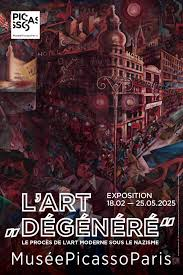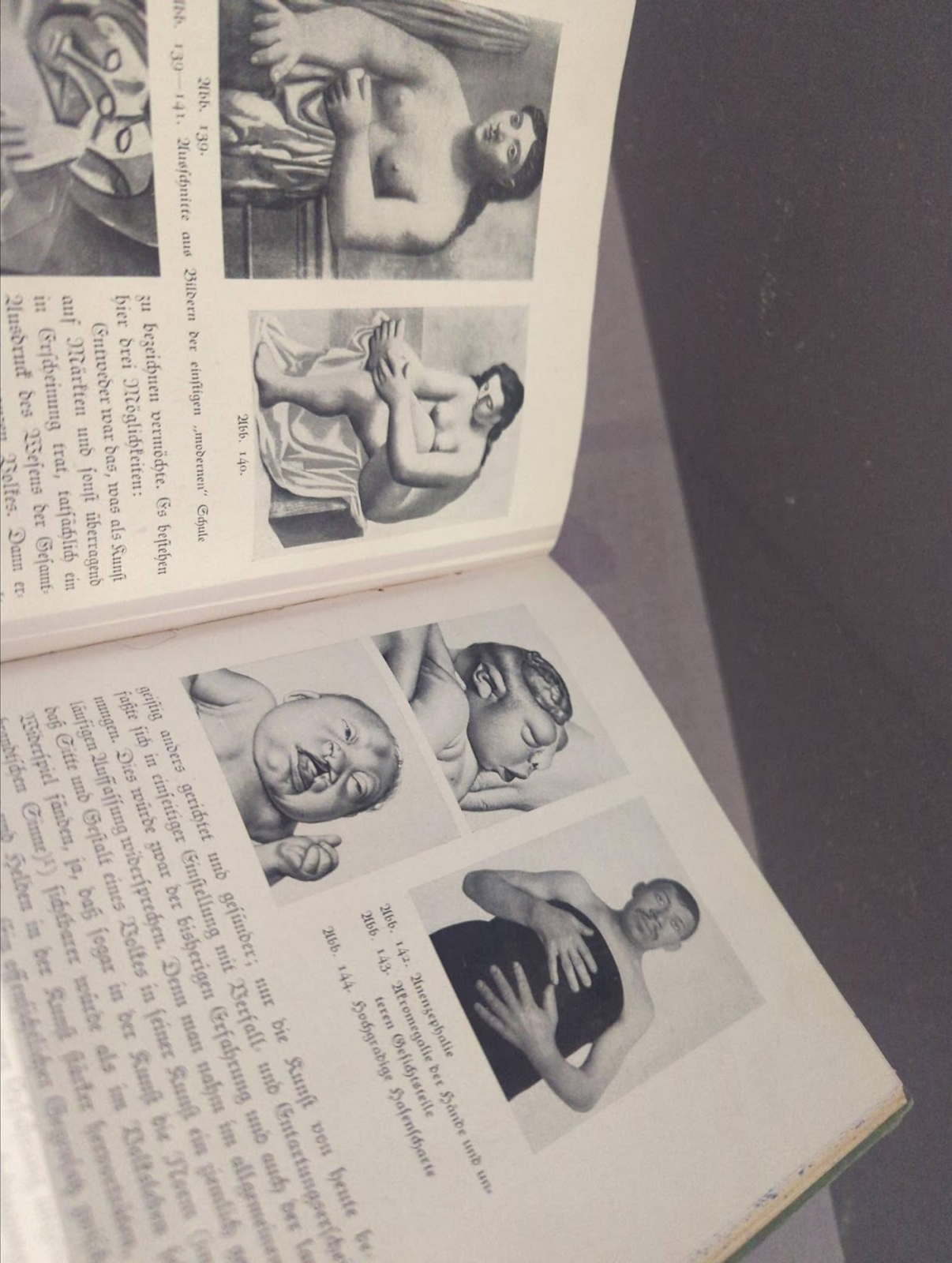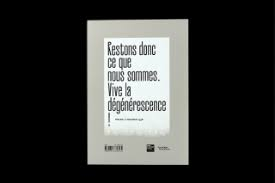My wife is doing some work
on one of the fathers of modern Art Therapy, Hans Prinzhorn, who worked with
patients in the psychiatric hospital of Heidelberg University in the 1920s and
early 1930s. After his death, the Nazis murdered many of the artists but also included
some of the art in an extraordinary exhibition – Entartete Kunst – Degenerate
Art.
The Picasso Museum in
Paris is currently hosting an exhibition of the same name, collecting together art
that survived the Nazi attack on this so-called degenerate culture and telling
the story of the Nazis’ relationship with Entartete Kunst. Josephine wanted to
go, she invited me to go with her. I enjoy hanging out with my wife.
The exhibition is, I think,
one of the most stunning and important I’ve ever seen. Partly because of the
way it tells a story about what happened then, but principally because of what
it tells us about what’s happening now.
Hitler, as we probably
know, fancied himself as an artist. He wasn’t a good artist, he was rejected by
the academy of Fine Arts in Vienna twice. And he never forgave … well millions
of people. And by the time he’s become Chancellor of Germany – and it’s worth
remembering he was indeed elected Chancellor of Germany in a democratic
election – he’s prepared to take his revenge. And art and artists were
denigrated, banished, destroyed, exiled and murdered. And in July 1937, the
Nazis opened Entatete Kunst – more than 700 works were shown on walls painted
with hate-filled slogans, “Revelation of the Jewish Racial Soul” or “Deliberate
Sabotage of the Armed Forces.” 4 million people visited – it’s staggering
really to imagine and amazing to see the grainy footage screened on the walls
of the Paris exhibition of crowds of well-to-do German housewives and Nazi high
officials wandering round the gallery.
The list of artists whose
work was exhibited is a roll call of the greatest artists of the time. There
were Jews – for Jews were among the greatest artists of the time – and the
Nazis certainly saw the Jews as degenerate.
There was Chagall – this
was included in the exhibition – it’s called The Pinch of Snuff or sometimes
The Rabbi of Vitebsk and was acquired by the Kunsthalle in Mannheim – the Nazis
dragged the art and the artist through the streets with a message attached
saying, “Taxpayer, you should know how your money was spent.” I knew the art –
I just, until I saw it on the wall this week, realised quite how large and
powerful a piece it was.
There was Oskar
Kokoshchka, whose work Alter Mann was exhibited – he lost his teaching position
at the Dresden Academy in 1933 and fled to Prague and then Great Britain. In
1943, he became president of the Free German Legue of Culture, the organisation
founded by Anti-Nazi cultural figures in exile.
But it wasn’t just the
Jewish artists who were held to be degenerate. This is Picasso’s Seated Nude.
This wasn’t in the original exhibition – it was looted by the Nazis in 1940
from the collection of the Parisian Jewish art dealer, Paul Rosenberg. But the
photo of this piece was used in the book, “Art & Race” by the Nazi Paul
Schultze-Naumburg and ridiculed – it was shown alongside photos of the disabled
as a way of … what exactly, sneering and creating a kind of guilt-by-throwing-nastiness.
And then there were the
cubists – degenerate.
And the fauvists –
degenerate.
And the artists who like
colour or abstraction or …
This one broke my heart a
little.

This is Ernst Barlach – it
looked to me like a weeping angel. It was exhibited, in the contemporary
exhibition under a quote from its sculptor that read, “These times don’t agree
with me, I’m not to its liking, I’m not all decked out in the nationalist fashion,
my mode is unracist, noise frightens me, instead of cheering when the “Heil”
sounds roar, instead of making arm gestures in the Roman style, I draw my hat
down over my brow.”
Barlach’s degeneracy, it
seems, is being too soft, to able to experience and present through art pain
and loss – degenerate by Nazi standards indeed. I stood infront of this statue
and this quote and I cried.
It turns out that to the
Nazis, it wasn’t just the Jewishness of the artist, it was the richness of the
use of colour, or line or shape, or sense of fun or – and this is the real
point – the sense of an artist being an artist.
For the point of art to
express that which cannot be otherwise expressed.
I remember Tracey Emin
being interviewed and asked to explain her work.
“I can’t really,” she
said, “because if I could have explained it, I wouldn’t have had to have made
it.”
Art exists to say things
that cannot be controlled or even expressed using what we already know. Art
exists to say the things that we don’t know yet, to open up the possibility of,
to those who see the art and are moved by the art, to experience something we
don’t already know. Great art – and my, I saw some great art in Paris this week
- makes us realise things we somehow
instinctively know are true, even we could never have expressed that truth
before now – before the very moment of seeing and feeling the art in our soul.
Art doesn’t fit. To create
art is to commit to a kind of iconoclasm – that word that literally means a
breaking of idols. And when as a dictatorial fascist regime, a government – and
I’m not just thinking of the Nazi government – demands that artists fit a
pre-realised sense of what truth is, that will always fail.
And even if that
dictatorial fascist regime destroys art and the first gallery in the exhibition
contains half destroyed pieces of Degenerate Art – the art survives, the ideas
survive.
And thank God they do.
Because if we just had the
things we already understood – or thought we already understood – if we just
had the science we understood at any given moment, we wouldn’t have a hope as
human beings. We’d be stuck never growing, never developing. We would never
have made it beyond smashing rocks together. It’s the art, it’s the iconoclasm
that opens up the possibility of growth, of learning, of realising the things
today we didn’t understand yesterday and realising too that there are new
things to learn tomorrow.
It's artists who
understand, perhaps better than us normal human beings the importance of that
line from Sameul Beckett’s Waiting for Godot – “Ever tried? Ever failed?
No matter. Try again, fail again, fail better.”
I think that’s why art and
artists so distress the dictators and the fascists and the autocrats. Because
they like things the way they are – when they are in power. And they don’t want
to look beyond the things they know already. They don’t like being told they
are failing.
That’s why, for what it’s
worth, Jews no longer offer sacrifices. Because we are artists in our religious
soul. And as much as there was beauty in that observance then, times changed
and we changed and there was creativity and bravery and there arose from the
rubble of the destroyed Second Temple a new idea even more beautiful than
sacrifices – and certainly less bloody.
That’s why, for what it’s
worth, New London was founded, because Rabbi Louis Jacobs just couldn’t bring
himself to tow a party line of acceptable tings that acceptable Orthodox Rabbis
were supposed to say. He wanted to say
the right thing, the thing that felt perhaps uncomfortable, made people feel
uneasy. He wanted to speak truth. I think Louis Jacobs, if he had been to Paris
to see this remarkable exhibition would have been proud to consider himself one
of the degenerates.
I think we should all be
proud to consider ourselves degenerates.
For, in truth, we are all
degenerate in our way. Artists of our own lives, trying failing, trying again,
failing again, failing better. All of us, a little too tall, or a little too
short or a little too fond of bright colours or pastel colours of sharp lines
or hazy lines or … in our idiosyncrasy and perfect individuality – we disturb
and disrupt this awful notion that seems to powerful and so dangerous in our
time and in the 1930s too – that we should all subscribe to some kind of
prescribed appropriateness. Vive la difference.
Salute the bravery of
those once did, and continue to, stand up to autocracy and fascism.
Salute the bravery of
those who once did, and continue to, seek to try again, fail again and fail
better.
Salute the incredible
diversity of humanity in all of its forms and in its creativity most especially.
As Otto Dix, another of the great artists oppressed by the and exhibited in 1937 in Munichg and today in the Picasso Museum in Paris, as Otto Dix said,
Restons donc ce queue nous sommes. Vive la degeneresence.
Let's be that which we are. Long live degenerecy.
Shabbat Shalom














